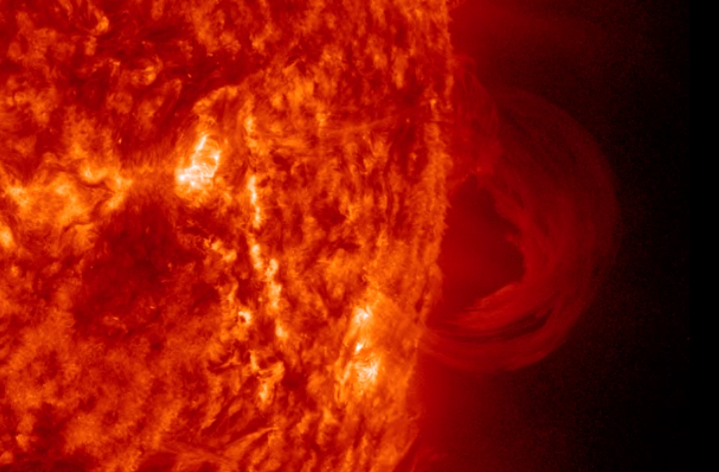Over the last few weeks, big, complex sunspot groups and associated high flaring activity got everybody's attention. One would almost forget that solar filaments are also part of the solar activity. Time for a change!
Solar filaments are clouds of ionized gas above the solar surface squeezed between magnetic regions of opposite polarity. Being cooler and denser than the plasma underneath and their surroundings, these magnetic borderlines appear as dark lines when seen on the solar disk using special filters. As filaments grow longer, they are more likely to erupt, showing a prominence (near the limb) and often accompanied by a coronal mass ejection (CME).

Last week, three nice eruptions occurred on resp. 10 March (east limb; 18:45-20:45UT), 13 March (west limb; 00:00-02:00UT) and 16 March (02:45-04:45UT). This movie shows each of them in SDO/AIA 304, 171 and 193 filters. These filters correspond to successively higher temperatures further up in the Sun's atmosphere, i.e. about 80.000 degrees (transition region), 650.000 degrees (upper transition region) and 1.250.000 degrees (corona). The image underneath shows the difference in outlook of the 13 March event (00:41UT) in the three different wavelengths.

Though every event concerned a filament eruption, they differed in various features from each other. For example, the 10 and 16 March filaments were quite long (about 30 degrees or the average Earth-Moon distance), whereas the 13 March filament was only 6 degrees long.
Usually, such long filaments stay away from active regions, but the northern end of the 10 March filament was very close to the trailing section of active region NOAA 2002. The 13 March filament's northern end was close to re-emerging region NOAA 2000, whereas the 16 March filament was buddying with another long and nearby filament to the west, and not near any sunspot region at all.

None of the three events seems to be associated to an x-ray flare. The 13 March event occurred in the aftermath of the M9 flare in NOAA 1996 (12 March, 22:34UT) near the northwest limb, so this filament eruption may have been triggered by this flaring event. Note something similar may have happened on 10 March, as NOAA 2002 produced an M1 flare at 15:28UT, just a few hours before the nearby filament eruption started.
In all three cases, post eruption coronal loops became visible, but only the 13 March event had loops over pretty much the entire length of the source filament ("arcade"). For the other two events, these loops were confined to small areas resp. in the north and the middle portion.

The prominences associated to these eruptive events all had a different shape. The 10 March prominence was the most complex and twisted. The 13 March prominence displayed a nice arch shape, with an inner bright rim of hot plasma. The 16 March prominence was not as bright as its predecessors, and resembled an ever expanding "light bulb", of which one of its legs of relatively cool (dark) plasma could be seen moving high above the solar surface. In all three events, one can also see material raining down onto the solar surface, as well as in the filament channel and in the remnants of the source or nearby filament.
If any coronal mass ejection (CME) was associated to the 10 March filament eruption, it is very likely that it was in the same direction as the CME that was already visible at 17:48UT in LASCO/C2. That one was probably associated to the M1 flare in nearby active region NOAA 2002. It came also into view well before the filament eruption started. The two other CMEs were a lot more obvious, in particular the 16 March CME. None of the CMEs had an Earth directed component, so those filaments need to fine-tune their next rebellion.

Credits - Imagery for these clips were taken from SDO and SOHO/LASCO, and put together with Helioviewer..
 |
 |





